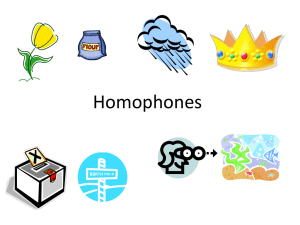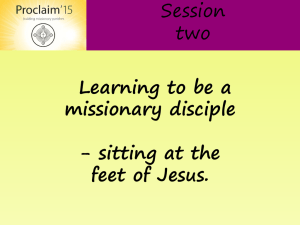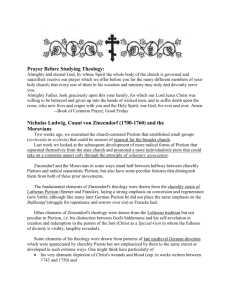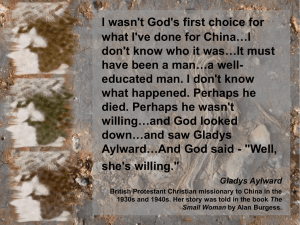Nicholaus Ludwig, Count von Zinzendorf
advertisement
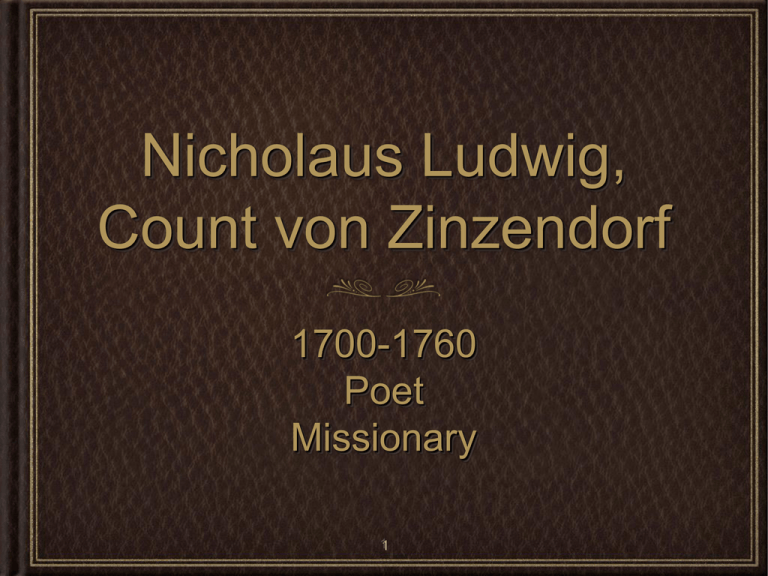
Nicholaus Ludwig, Count von Zinzendorf 1700-1760 Poet Missionary 1 Nicolaus Ludwig, Count von Zinzendorf 1700-1760 2 Here is what he wrote in his diary at age 15: This week I began the plan of spending a whole hour, from six to seven in the morning, as well as in the evening from eight to nine, and for fifteen minutes at a quarter of ten, in prayer. Also I resolved to pursue the study of civil law with all my energy. . . . Examinations with Mencken. At ten o’clock I fenced. At eleven I studied the pandects [the laws of a country]. At twelve I dined. At one I played badminton. At two I drew. At three I attended a lecture in the history of the Reich. At four I danced. At five Bardin (French tutor) was here. At six I studied civil law. At seven I dined. At eight I prayed. At nine I studied Hoppi’s examination. 3 He wrote many hymns, and some are in our hymnal. His most famous one is sung in 90 languages and has 33 stanzas. It is in our 1941 hymnal as #676 and only uses 4 stanzas: Jesus, still lead on Till our rest be won, And although the way be cheerless, We will follow, calm and fearless. . . . In our new hymnal is another of his hymns, #177, “Jesus, Your Blood and Righteousness.” The tune to this one is more familiar to us. 4 Because he was born a nobleman, when his school was over at home, he was sent on a grand tour of Europe to polish his education. While at Dusseldorf, he viewed the portrait by Domenico Feti of Jesus crowned with thorns and beneath it he read, “All this I did for thee; what doest thou for me?” This spoke to his heart and changed his life. He wondered what he was doing for Jesus, and from then on he resolved to live completely for Jesus. He was only a young adult at the time. 5 Christians in Moravia were being persecuted-some imprisoned, some loaded with chains, some yoked to the plough to work as horses, and some forced to stand in wells of water until nearly frozen. A Protestant Moravian named Christian David asked Zinzendorf if some persecuted Protestants in Moravia could find refuge at his estate. The heart of the Count was touched by their plight, and he promised David that if they would come, he would provide a place of abode for them. 6 And across the mountains, by winding and unknown paths, they came, a little band of emigrants. For the sake of their faith, they left their goods and personal possessions behind. Their march was long and wearisome and when they arrived at the estate of Count Zinzendorf, they were worn out and footsore. They came as wanderers from a foreign land and were not able to bring with them any certificates of orthodoxy. 7 Count Zinzendorf was not at home. His steward was in charge, and he realized these strangers could be dangerous heretics, but his master would not want them turned away, so he led the little group to a stretch of ground that belonged to the Count, about a mile away from the village, and told them to rest in an unfinished farm house. Soon they were building their own homes, and this was the beginning of Herrnhut. 8 Herrnhut 100 houses built on rising ground Evergreen woods on two sides and gardens and cornfields on the other two sides High hills in the background One long street, in the middle of which was the orphanage At one end was the chapel, which could hold 600-700 people. At the other end was Zinzendorf’s home. Another row of houses went in the opposite direction, dividing Herrnhut into two squares. 9 After his troubled crossing on the Simmonds, John Wesley visited Herrnhut and said it was a place where he would have loved to spend his life. The people’s conversation, he noted, was in heaven, and they had the mind of Christ and walked as he walked, with the spirit of meekness and love. He found them almost peculiar. Their burials, for example, were simple. At one time he tried to console a father as he buried his infant child but soon realized the man did not need his words of comfort, for he had found a higher consolation in his Saviour. 10 In the evening all the young men marched around the town singing praises and playing instruments and then gathered in a circle on a hill for evening prayer. They returned to their homes singing more hymns and wishing every one a good night. 11 This was Herrnhut. Herrnhut was based upon the plan of reforming the established church of its bad practices by forming little churches within them. The Wesleys followed this plan when they started Methodism. 12 Herrnhut is also known for the missionaries that left their midst. 13 In 1732, Zinzendorf and the Herrnhut congregation sent Leonard Dober and David Nitschmann as missionaries to the slaves on the sugar plantations on St. Thomas Island in the Caribbean. 14 Leonard Duber Missionary to St. Thomas Duber was only 19 years old when he left Herrnhut as a missionary. 15 David Nitschman n Missionary to St. Thomas David was an older gentleman, but he only stayed with Leonard for a few months. 16 Sugar Cane Field Work 17 Sugar Cane Field Work 18 Zinzendorf as missionary 19 Mayflower 20 Pilgrims on Mayflower 21 On October 14, 1735, both Wesley brothers left England for America. After settling in, there is their schedule: 4-5 a.m. private prayers 5-7 a.m. Bible reading together with their group 7 a.m. breakfast 8 a.m. public prayers 9 a.m.-12 noon German/Greek study, write sermons 12 meet together to give an account of the morning 1 p.m. dinner Following dinner until 4 p.m. reading to those they had taken in charge 4 p.m. evening prayers/Bible instruction 5-6 p.m. private prayers 6-7 p.m. read to other passengers (about 80 English were on board) 7 p.m. joined the Germans (the Moravians) in their public prayers 8 p.m. group meeting 9-10 p.m. bedtime 22 Their days were uneventful unless storms brewed, of which there were at least four on this trip. The fourth one was particularly severe. John Wesley described it in his journal: 23 In the midst of the psalm wherewith their [the Moravians’] service began, the sea broke over, split the mainsail in pieces, covered the ship, and poured in between the decks, as if the great deep had already swallowed us up. A terrible screaming began among the English. The Germans calmly sung on. I asked one of them afterwards, “Were you not afraid?” He answered, “I thank God, no.” I asked, “But were not your women and children afraid?” He replied, mildly, “No; our women and children are not afraid to die.” 24 On February 5, the Simmonds cast anchor in the Savannah River, and February 6 the Wesleys set foot on American soil for the first time. 25 John Wesley 26 John Wesley 27 John Wesley 28 Credits: Slide 2, Skara kommun Slides 15, 16, 19, 20, 21, 27: United States Public Domain Slide 26: David Muir Slide 28: Pete Reed 29

